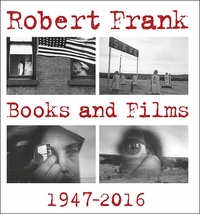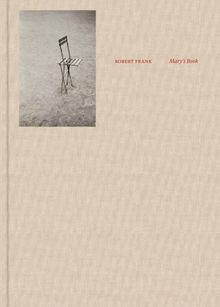PHOTOGRAPHY MONOGRAPHS
|
|
STATUS: Forthcoming | 6/24/2025 This title is not yet published in the U.S. To pre-order or receive notice when the book is available, please email orders @ artbook.com |
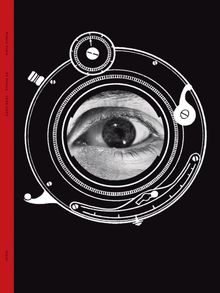 Robert Frank: Portfolio
Robert Frank: Portfolio
Published by Steidl.
When Robert Frank (1924–2019) emigrated from Zurich to the United States in 1947, the aspiring young photographer brought along his portfolio of 40 photos to help him secure employment. This eponymous volume is the facsimile of that very object. It contains Frank’s earliest original photographs, taken between 1941 and 1946, as well as the images of other photographers that he had retouched. We see images of rural landscapes in Switzerland juxtaposed alongside street scenes, antique shops, fine fabrics and the glowing lights of a cinema. Portfolio thus contains the seeds of a career of such scope and influence which even the ambitious, 23-year-old Robert Frank could not have anticipated. Designed by the artist in collaboration with Gerhard Steidl, the facsimile’s softcover presentation in a cardboard envelope mimics the way Frank would have originally stored this crucial selection of his work. It is also, in a sense, his first photobook, providing a glimpse into his sequencing process that would produce such acclaimed publications as The Americans and The Lines of My Hand.
PUBLISHER
Steidl
BOOK FORMAT
Slip, pbk, 8 x 10.75 in. / 40 pgs / 39 tritone.
PUBLISHING STATUS
Pub Date 1/7/2025
Active
DISTRIBUTION
D.A.P. Exclusive
Catalog: SPRING 2025 p. 50
PRODUCT DETAILS
ISBN 9783958290228 TRADE
List Price: $45.00 CAD $68.00
AVAILABILITY
In stock
in stock $45.00 Free Shipping UPS GROUND IN THE CONTINENTAL U.S. |
 Robert Frank: Hope Makes Visions
Robert Frank: Hope Makes Visions
Published by Pace Publishing.
Text by Ocean Vuong, Shahrzad Kamel.
Widely regarded as one of the most influential figures in the history of his medium, Robert Frank broke new ground with his candid, poignant images of American life in the mid-20th century. Published on the occasion of the exhibition at Pace in New York, and in celebration of the centennial of Frank’s birth, Robert Frank: Hope Makes Visions presents an in-depth look at the photographer and filmmaker’s process across various media. Through a selection of his lesser-known photographs, collages, sketches and maquettes from 1955 to 2016, a new portrait of the artist emerges, one that shows his commitment to growth and experimentation throughout his career. With a new text by Ocean Vuong, author of the award-winning On Earth We're Briefly Gorgeous (2019), this volume is a sensitive homage to a canonical artist.
Robert Frank was born in Zurich, Switzerland, in 1924. He spent most of his adult life living between New York City and Nova Scotia, Canada, where he died in 2019. Frank was a photographer and filmmaker best known for his groundbreaking monograph The Americans (1958). Over his decades-long career, Frank captured the complexities of contemporary life with a distinct style and poetic insight.
PUBLISHER
Pace Publishing
BOOK FORMAT
Paperback, 9.75 x 12.25 in. / 100 pgs / 7 color / 47 duotone.
PUBLISHING STATUS
Pub Date 2/11/2025
Active
DISTRIBUTION
D.A.P. Exclusive
Catalog: SPRING 2025 p. 4
PRODUCT DETAILS
ISBN 9781948701785 TRADE
List Price: $45.00 CAD $67.50 GBP £38.00
AVAILABILITY
In stock
in stock $45.00 Free Shipping UPS GROUND IN THE CONTINENTAL U.S. |
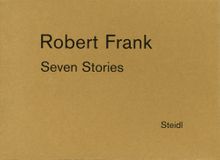 Robert Frank: Seven Stories
Robert Frank: Seven Stories
Published by Steidl.
Originally released in 2009, Seven Stories was the first publication of Robert Frank’s Polaroids. Quickly sold-out, it has been a collector’s rarity ever since. This 2024 edition makes the book available again at long last, shepherding his extraordinary series to a whole new audience.
After completing The Americans, Frank put aside the still image and concentrated throughout the 1960s on filmmaking. He returned to still photography only in the 1970s, using a Polaroid camera with black-and-white positive/negative film. In recent years, Frank worked almost exclusively with Polaroids, exploring the collage and assemblage possibilities of the instant photograph.
This slipcased collection of small, staple-bound books represents a new stage in the practice of a remarkable artist who continually challenged the limits of photography and film and strove to avoid repeating himself. As always, the photographs and stories relate to Frank’s life and milieu, his homes in Mabou and New York and his travels, including trips to China and Spain.
PUBLISHER
Steidl
BOOK FORMAT
Slip, pbk, 7 vols, 5.5 x 4 in. / 124 pgs / 71 color / 16 bw.
PUBLISHING STATUS
Pub Date 9/30/2025
Forthcoming
DISTRIBUTION
D.A.P. Exclusive
Catalog: FALL 2024 p. 28
PRODUCT DETAILS
ISBN 9783969993668 TRADE
List Price: $45.00 CAD $62.00
AVAILABILITY
Awaiting stock
STATUS: Forthcoming | 9/30/2025 This title is not yet published in the U.S. To pre-order or receive notice when the book is available, please email orders @ artbook.com |
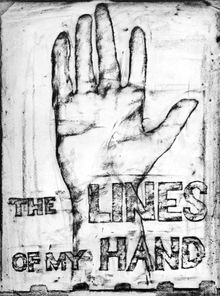 Robert Frank: The Lines of My Hand
Robert Frank: The Lines of My Hand
Published by Steidl.
Text by Robert Frank.
After The Americans (1958), The Lines of My Hand is arguably Robert Frank’s most important book, and without a doubt the publication that established his autobiographical, sometimes confessional approach to bookmaking. The book was originally published by Yugensha in Tokyo in 1972, and this reprint of the 2017 Steidl edition—made in close collaboration with Robert Frank—follows and updates the first US edition by Lustrum Press of 1972.
The Lines of My Hand is structured chronologically and presents selections from every stage of Frank’s work until 1972—from early photos in Switzerland in 1945–46 to images of his travels in Peru, Paris, Valencia, London and Wales and contact sheets from his 1955–56 journey through the US that resulted in The Americans and launched him into fame. Here too are intimate photos of Frank’s young family, later photo-collages and stills from films including Pull My Daisy (1959) and About Me: A Musical (1971). The structure of the book mirrors the rhythm of Frank’s life, and his short personal texts, such as diary entries, bring his voice into the book.
In its singular combination of text and image, its fearless self-reflection and its insistence on photography and film as equal yet different parts of his art, The Lines of My Hand proved an inspiration for many photographers—not least Robert Frank himself, who expanded this approach in his visual diaries of 2010–17.
PUBLISHER
Steidl
BOOK FORMAT
Paperback, 9 x 12 in. / 116 pgs / 160 bw.
PUBLISHING STATUS
Pub Date 9/30/2025
Forthcoming
DISTRIBUTION
D.A.P. Exclusive
Catalog: FALL 2024 p. 27
PRODUCT DETAILS
ISBN 9783969993675 TRADE
List Price: $60.00 CAD $87.50
AVAILABILITY
Awaiting stock
STATUS: Forthcoming | 9/30/2025 This title is not yet published in the U.S. To pre-order or receive notice when the book is available, please email orders @ artbook.com |
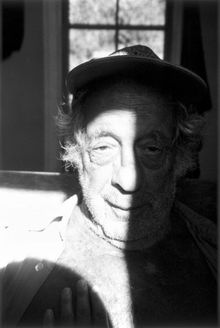 Robert Frank: Visual Diaries
Robert Frank: Visual Diaries
Published by Steidl.
Text by Robert Frank.
The Visual Diaries presents, for the first time together, the six introspective volumes that are most critical to Robert Frank’s late bookmaking practice. Originally published between 2010 and 2017, the books imaginatively combine iconic photos from Frank’s early career with the more private pictures he made in later life. Black-and-white photos taken on 35mm film, including some from The Americans, mix with contemporary Polaroids. Quiet still lifes, contemplative landscapes and urban scenes, self-portraits, and spontaneous endearing shots of friends, colleagues and his wife, June Leaf, show the life he lived in their homes on Bleecker Street in New York and in Mabou, Nova Scotia. With these images Frank created seemingly casual layouts that recall the look and spirit of a private album or scrapbook and comment on memory and the passage of time. Factual captions and short, sometimes cryptic texts are scattered throughout the books. Frank’s highly personal approach to these books suggests how the past tempered his present and shows how his life was not just documented but shaped by bookmaking. Until his death in 2019, Robert Frank remained as innovative and ambitious as ever; Visual Diaries is the primary expression of his steadfast artistic curiosity.
PUBLISHER
Steidl
BOOK FORMAT
Slip, pbk, 6 vols, 8 x 9.75 in. / 296 pgs / 35 color / 181 bw.
PUBLISHING STATUS
Pub Date 9/30/2025
Forthcoming
DISTRIBUTION
D.A.P. Exclusive
Catalog: FALL 2024 p. 31
PRODUCT DETAILS
ISBN 9783969993651 TRADE
List Price: $80.00 CAD $120.00
AVAILABILITY
Awaiting stock
STATUS: Forthcoming | 9/30/2025 This title is not yet published in the U.S. To pre-order or receive notice when the book is available, please email orders @ artbook.com |
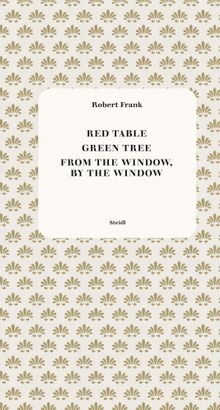 Robert Frank: Red Table, Green Tree, From the Window, by the Window
Robert Frank: Red Table, Green Tree, From the Window, by the Window
Published by Steidl.
The Polaroid camera, with its unique prints, was one of Robert Frank’s (1924–2019) favorite ways of making photographs. Red Table, Green Tree and From the Window, by the Window are three volumes of rarely or unseen original Polaroid and Fuji Instax facsimiles. Volume one, Red Table, includes images of a small red table Frank found in an antique shop in New Glasgow. The table found its place in the vestibule of the home Frank shared with his wife, artist June Leaf, in Mabou, Nova Scotia. He photographed it multiple times, in different light conditions and with ever-changing objects on its surface. Volume two, Green Tree, presents photographs of the landscape, specifically trees, with their myriad foliage throughout the seasons. Volume three, From the Window, by the Window, contains views from various windows around Frank’s Mabou home, with the focus shifting between the distant sea and the souvenirs he loved to collect. Organized by A-chan, who worked closely with Frank on his later books with Steidl, the instant prints are sorted in albums purchased from a drugstore. Frank and A-chan used these albums as a way to categorize his works, a system Frank incorporated throughout his career.
PUBLISHER
Steidl
BOOK FORMAT
Slip, pbk, 3 vols, 6.75 x 12.5 in. / 194 pgs / 406 color.
PUBLISHING STATUS
Pub Date 9/30/2025
Forthcoming
DISTRIBUTION
D.A.P. Exclusive
Catalog: FALL 2024 p. 28
PRODUCT DETAILS
ISBN 9783969993644 TRADE
List Price: $80.00 CAD $120.00
AVAILABILITY
Awaiting stock
STATUS: Forthcoming | 9/30/2025 This title is not yet published in the U.S. To pre-order or receive notice when the book is available, please email orders @ artbook.com |
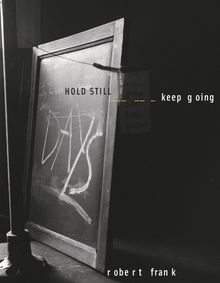 Robert Frank: Hold Still, Keep Going
Robert Frank: Hold Still, Keep Going
Published by Steidl.
Edited with text by Ute Eskildsen. Text by Wolfgang Beilenhoff, Christoph Ribbat.
This edition of Hold Still, Keep Going is the second reprint of the catalog to Robert Frank’s 2001 exhibition of the same name at Museum Folkwang in Essen. Although the artist is best known for his seminal photobook The Americans (1958) and his experimental film Pull My Daisy (1959), until this publication, little scholarship existed on the intersection between Frank’s work in the disciplines of photography and film. Hold Still, Keep Going fills that void, exploring the role of film in Frank’s work and the interaction between the still and moving image that engaged him since the late 1950s. Adopting a nonchronological approach, the volume blends together photographs, film stills, 35mm filmstrips and photo-montages, presenting his most famous series alongside lesser-known work. From these varied contents, the volume offers revealing juxtapositions, rendering more cohesive the seemingly disjointed arc of Frank’s oeuvre. Text—from handwritten phrases on photographs (of which “Hold Still, Keep Going” is one example) to the dialogue in his films—emerges as a crucial tool, one also central to Frank’s visual diaries which comprised his later experiments in bookmaking.
Including texts from scholar Wolfgang Beilenhoff and author Christoph Ribbat, Hold Still, Keep Going provides insight into the relatively obscure work by perhaps one of history’s best-known photographers.
PUBLISHER
Steidl
BOOK FORMAT
Clth, 8 x 10.5 in. / 168 pgs / 13 color / 87 bw.
PUBLISHING STATUS
Pub Date 9/30/2025
Forthcoming
DISTRIBUTION
D.A.P. Exclusive
Catalog: FALL 2024 p. 29
PRODUCT DETAILS
ISBN 9783969993699 TRADE
List Price: $60.00 CAD $87.50
AVAILABILITY
Awaiting stock
STATUS: Forthcoming | 9/30/2025 This title is not yet published in the U.S. To pre-order or receive notice when the book is available, please email orders @ artbook.com |
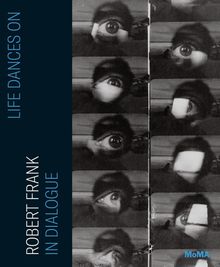 Life Dances On: Robert Frank in Dialogue
Life Dances On: Robert Frank in Dialogue
Published by The Museum of Modern Art, New York.
Edited with text by Lucy Gallun. Text by Kaitlin Booher, Sarah Greenough.
This volume, published in conjunction with the artist’s first solo exhibition at the Museum of Modern Art, New York, provides new insights into the interdisciplinary and lesser-known aspects of Robert Frank’s expansive career. The exhibition explores the six decades that followed his landmark photobook The Americans, a period in which Frank maintained an extraordinarily multifaceted practice characterized by perpetual experimentation across mediums and artistic and personal dialogues with other artists and with his communities. Coinciding with the centennial of his birth, this catalog takes its name from the artist’s poignant 1980 film, Life Dances On, in which Frank reflects on the individuals who have shaped his outlook.
The lushly illustrated publication features photographs, films, books and archival materials, layered with quotes from Frank on his influences and process. Three scholarly essays, excerpts from previously unpublished video footage and a rich visual chronology together explore Frank’s ceaseless creative exploration and observation of life.
Robert Frank was a Swiss American photographer and filmmaker best known for his groundbreaking monograph The Americans (1958). Over his decades-long career, Frank captured the complexities of contemporary life with a distinct style and poetic insight. He lived between New York City and Nova Scotia, Canada.
PUBLISHER
The Museum of Modern Art, New York
BOOK FORMAT
Hardcover, 9 x 10.5 in. / 192 pgs / 150 color / 150 bw.
PUBLISHING STATUS
Pub Date 9/24/2024
Active
DISTRIBUTION
D.A.P. Exclusive
Catalog: FALL 2024 p. 7
PRODUCT DETAILS
ISBN 9781633451643 TRADE
List Price: $60.00 CAD $87.50
AVAILABILITY
In stock
in stock $60.00 Free Shipping UPS GROUND IN THE CONTINENTAL U.S. |
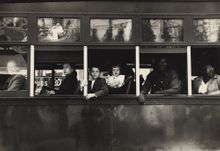 Robert Frank: Trolley—New Orleans
Robert Frank: Trolley—New Orleans
MoMA One on One Series
Published by The Museum of Modern Art, New York.
Text by Lucy Gallun.
In the midst of an extended road trip across the United States, Robert Frank turned from bustling Canal Street, New Orleans, where crowds of people swarmed the sidewalks, pointed his camera lens at a passing trolley, and clicked the shutter. That single exposure produced a picture with enduring clarity: a row of windows framing the street car’s passengers—white passengers in the front, black passengers in the back.
Frank captured individual faces gazing from each rectangular frame, from the weary Black man in his work shirt to the young white girl just in front of him, her hand resting on the wooden sign that designated areas segregated by race. In 1958, he wrote: “With these photographs, I have attempted to show a cross-section of the American population. My effort was to express it simply and without confusion.” By the time The Americans was published in the United States in 1959, with this image now appearing on its front cover, New Orleans streetcars and buses had been desegregated through a 1958 court order. But Jim Crow was still in full swing, the 1960s Civil Rights struggles still ahead. An essay by MoMA curator Lucy Gallun conveys how this image reverberates in new contexts today.
PUBLISHER
The Museum of Modern Art, New York
BOOK FORMAT
Paperback, 7.25 x 9 in. / 48 pgs / 35 color.
PUBLISHING STATUS
Pub Date 3/9/2021
Active
DISTRIBUTION
D.A.P. Exclusive
Catalog: FALL 2020 p. 29
PRODUCT DETAILS
ISBN 9781633451193 TRADE
List Price: $14.95 CAD $20.95
AVAILABILITY
In stock
in stock $14.95 Free Shipping UPS GROUND IN THE CONTINENTAL U.S. |
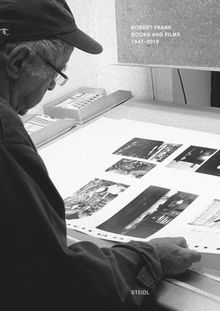 Robert Frank: Books and Films, 1947–2019
Robert Frank: Books and Films, 1947–2019
Published by Steidl.
Edited by Gerhard Steidl. Text by John Farrel, Gerhard Steidl, Monte Packham. Interview between Robert Frank, Robert Enright, Meeka Walsh. Interview between Gerhard Steidl, Fritz Göttler.
Exploring Robert Frank’s rich bookmaking history with Steidl, and featuring spreads and explanatory texts from the more than 30 books that Frank published with Steidl, along with interviews, essays and documentary photos, Books and Films, 1947–2019 is a tribute to Frank’s diverse and influential bookmaking practice.
Gerhard Steidl began working with Robert Frank in 1989, when Swiss publisher Walter Keller asked him to print Frank’s The Lines of My Hand for his imprint Scalo: “You’ll both get along well on press,” Keller had said. And so Robert Frank traveled to Steidl at Düstere Strasse 4 in Göttingen for the first of many visits, to be on press and sign off each printed sheet.
After Scalo closed its doors in 2004, Steidl started to publish as well as print Frank’s books, beginning a long-term working friendship that encompassed every aspect of Frank’s creativity—from reprints of his classic and some lesser-known books (The Americans, Zero Mostel Reads a Book) and the publication of previously unseen projects (Seven Stories) to newly conceived volumes (Tal Uf Tal Ab, Good Days Quiet), as well as his complete films on DVD (Film Works).
In Gerhard Steidl’s words: “Our aim has been to ensure the legacy of this original and seminal artist and that his work will be available and accessible for years to come—all in a form and to a standard that Robert personally oversaw.”
PUBLISHER
Steidl
BOOK FORMAT
Hardcover, 8.25 x 11.75 in. / 120 pgs / 4 color / 75 bw.
PUBLISHING STATUS
Pub Date 11/10/2020
Active
DISTRIBUTION
D.A.P. Exclusive
Catalog: SPRING 2020 p. 37
PRODUCT DETAILS
ISBN 9783958293069 TRADE
List Price: $30.00 CAD $42.00
AVAILABILITY
In stock
in stock $30.00 Free Shipping UPS GROUND IN THE CONTINENTAL U.S. |
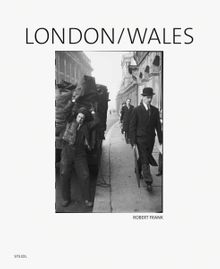 Robert Frank: London/Wales
Robert Frank: London/Wales
Published by Steidl.
This magnificent edition of London/Wales—a reprint of the 2007 Steidl edition that included never-before-seen photographs, expanding on Scalo's first edition of 2003—juxtaposes Frank's images of the elegant world of London money with the grimy working-class world of postwar Wales. It brings together two distinct bodies of work, and reveals a significant documentary precedent for The Americans. It also offers an important view of Frank's development, demonstrating an early interest in social commentary, in the narrative potential of photographic sequencing, and innovative use of the expressionistic qualities of the medium.
PUBLISHER
Steidl
BOOK FORMAT
Hardcover, 8 x 9.75 in. / 128 pgs / 70 bw.
PUBLISHING STATUS
Pub Date 6/18/2019
Active
DISTRIBUTION
D.A.P. Exclusive
Catalog: SPRING 2019 p. 10
PRODUCT DETAILS
ISBN 9783958290396 TRADE
List Price: $45.00 CAD $60.00
AVAILABILITY
Out of stock
STATUS: Out of stock Temporarily out of stock pending additional inventory. |
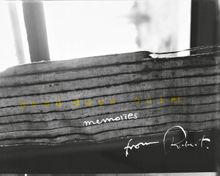 Robert Frank: Good days quiet
Robert Frank: Good days quiet
Published by Steidl.
In this, Robert Frank’s newest book, he both acknowledges and moves beyond his acclaimed visual diaries (2010–17), which juxtapose iconic photos from throughout his career with the more personal pictures he makes today and suggestive, often autobiographical text fragments. In Good days quiet Frank’s focus is life inside and outside his beloved weather-beaten wooden house in Mabou, where he has spent summers for decades with his wife June Leaf.
Among portraits of Leaf, Allen Ginsberg and Frank’s son are images of the house’s simple interior with its wood-fueled iron stove, humble furniture and bare light bulbs, and views of the land and sea by the house: snow-covered, windswept, stormy or lit by the dying sun.
Frank’s Polaroid prints show various deliberate states of deterioration and manipulation at his hands, including texts that move from the merely descriptive (“watching the crows”) to the emotive (“memories,” “grey sea—old house / can you hear the music”). As always in Frank’s books, his message lies primarily in the photos’ lyrical sequence, an influential approach to the photobook pioneered by and today well at home in his 94-year-old hands.
Robert Frank was born in Zurich in 1924 and immigrated to the United States in 1947. He is best known for his seminal book The Americans, first published in English in 1959, which gave rise to a distinctly new form of the photobook, and his experimental film Pull My Daisy (1959). Frank’s other important projects include the books Black White and Things (1954), The Lines of My Hand (1972) and the film Cocksucker Blues for the Rolling Stones (1972). He divides his time between New York City and Nova Scotia, Canada.
PUBLISHER
Steidl
BOOK FORMAT
Slip, pbk, 10 x 8 in. / 64 pgs / 39 bw.
PUBLISHING STATUS
Pub Date 4/23/2019
Active
DISTRIBUTION
D.A.P. Exclusive
Catalog: SPRING 2019 p. 75
PRODUCT DETAILS
ISBN 9783958295506 TRADE
List Price: $40.00 CAD $56.00
AVAILABILITY
In stock
in stock $40.00 Free Shipping UPS GROUND IN THE CONTINENTAL U.S. |
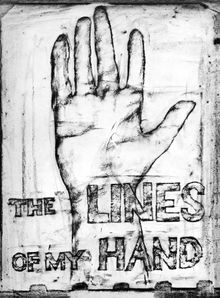 Robert Frank: The Lines of My Hand
Robert Frank: The Lines of My Hand
Published by Steidl.
Text by Robert Frank.
The book was originally published by Yugensha in Tokyo in 1972, and this new Steidl edition, made in close collaboration with Frank, follows and updates the first US edition by Lustrum Press of 1972.
The Lines of My Hand is structured chronologically and presents selections from every stage of Frank’s work until 1972—from early photos in Switzerland in 1945–46, to images of his travels in Peru, Paris, Valencia, London and Wales, and to contact sheets from his 1955–56 journey through the US that resulted in The Americans. Here too are intimate photos of Frank’s young family, later photo-collages and stills from films including Pull My Daisy and About Me: A Musical.
PUBLISHER
Steidl
BOOK FORMAT
Paperback, 9 x 12 in. / 102 pgs / 160 bw.
PUBLISHING STATUS
Pub Date 2/27/2018
Out of print
DISTRIBUTION
D.A.P. Exclusive
Catalog: FALL 2017 p. 95
PRODUCT DETAILS
ISBN 9783958293205 TRADE
List Price: $35.00 CAD $47.50
AVAILABILITY
Not available
STATUS: Out of print | 00/00/00 For assistance locating a copy, please see our list of recommended out of print specialists |
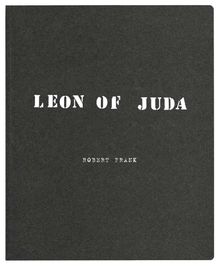 Robert Frank: Leon of Juda
Robert Frank: Leon of Juda
Published by Steidl.
Here, still lifes taken in Frank’s home in Bleecker Street, New York, and landscapes around his house in Mabou, Nova Scotia, jostle alongside spontaneous portraits of friends, colleagues and his wife, the artist June Leaf, as well as vintage postcards. With these images Frank creates a seemingly casual layout that recalls the look and spirit of a private album or scrapbook.
Equally humble and ambitious, Leon of Juda shows how the past tempers Frank’s present and how his life is not only documented in, but shaped by, bookmaking.
PUBLISHER
Steidl
BOOK FORMAT
Slip, pbk, 8 x 9.75 in. / 52 pgs / 10 color / 33 bw.
PUBLISHING STATUS
Pub Date 11/21/2017
Active
DISTRIBUTION
D.A.P. Exclusive
Catalog: FALL 2017 p. 95
PRODUCT DETAILS
ISBN 9783958293113 TRADE
List Price: $30.00 CAD $40.00
AVAILABILITY
In stock
in stock $30.00 Free Shipping UPS GROUND IN THE CONTINENTAL U.S. |
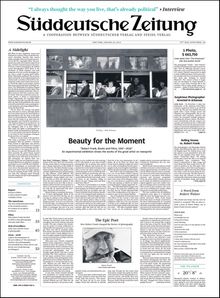 Robert Frank: Books and Films
Robert Frank: Books and Films
1947–2016
Published by Steidl/Süddeutsche Zeitung, Munich.
Edited with text by Alex Rühle. Text by Philip Brookman, Robert Frank, Sarah Greenough, Gerhard Steidl.
The exhibition presents six decades of books and films made by Robert Frank (born 1924) against the background of his iconic photographs. These images are shown in an immediate and straightforward way--printed on nearly 10-foot sheets of newsprint and installed unframed on the wall--and contextualized with information about Frank’s life, his working processes and broader cultural history.
Robert Frank: Books and Films, 1947–2016 recreates the raw, innovative approach of the exhibition in an unpretentious and accessible printed object. Frank himself summarizes the appeal of the “catalogue”: “Cheap, quick and dirty, that’s how I like it!”
PUBLISHER
Steidl/Süddeutsche Zeitung, Munich
BOOK FORMAT
Paperback, 15.75 x 22.5 in. / 64 pgs / illustrated throughout.
PUBLISHING STATUS
Pub Date 1/24/2017
Out of stock indefinitely
DISTRIBUTION
D.A.P. Exclusive
Catalog: FALL 2016 p. 30
PRODUCT DETAILS
ISBN 9783869309866 SDNR50
List Price: $25.00 CAD $34.50
AVAILABILITY
Not available
STATUS: Out of stock indefinitely. |
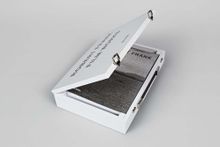 Robert Frank: Film Works
Robert Frank: Film Works
Published by Steidl.
Edited by Laura Israel.
The significance of Robert Frank’s photography is unquestionable. His The Americans is arguably the most important American photography publication of the postwar period, and his work has spawned numerous disciples, as well as a rich critical literature. It is less known that at the very moment he became a star—the end of the 1950s—Frank chose to abandon still photography for more than ten years in order to immerse himself in filmmaking. He did return to photography in the 1970s, but Frank the filmmaker has remained a well-kept secret for almost four decades. A compilation examining his missing years is long overdue. Film Works includes four DVDs in PAL and NTSC format, and comes with the book Frank Films (edited by Brigitta Burger-Utzer and Stefan Grissemann)—offering a visually unique approach to Frank’s films—and the booklets Me & My Brother and Pull My Daisy, all packaged in a custom-made wooden case. This elaborate object provides a comprehensive overview of more than 25 films and videos, some of them classics of the New American Cinema of the 1950s and 1960s.
Digital Mastering by Assemblage Inc./Laura Israel.
Robert Frank was born in Zurich in 1924 and immigrated to the United States in 1947. He is best known for his seminal book The Americans, first published in 1958, which gave rise to a distinctly new form of the photobook, and his experimental film Pull My Daisy (1959). Frank’s other important projects include the books Black, White and Things (1952), The Lines of My Hand (1972) and the film Cocksucker Blues for the Rolling Stones (1972). He divides his time between New York City and Nova Scotia, Canada.
PUBLISHER
Steidl
BOOK FORMAT
Boxed, Paperback, 4 vols, 8.25 x 11.75 in. / 400 pgs / 4 DVDS (PAL & NTSC).
PUBLISHING STATUS
Pub Date 10/25/2016
Active
DISTRIBUTION
D.A.P. Exclusive
Catalog: SPRING 2016 p. 18
PRODUCT DETAILS
ISBN 9783958290365 SDNR40
List Price: $175.00 CAD $235.00
AVAILABILITY
In stock
in stock $175.00 Free Shipping UPS GROUND IN THE CONTINENTAL U.S. |
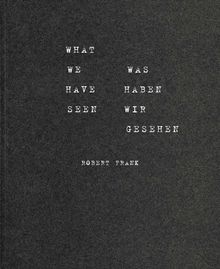 Robert Frank: What We Have Seen
Robert Frank: What We Have Seen
Published by Steidl.
Text by Robert Frank, Ayumi Yamazaki.
PUBLISHER
Steidl
BOOK FORMAT
Slip, Paperback, 8.75 x 9.75 in. / 48 pgs / illustrated throughout.
PUBLISHING STATUS
Pub Date 3/22/2016
Active
DISTRIBUTION
D.A.P. Exclusive
Catalog: SPRING 2016 p. 19
PRODUCT DETAILS
ISBN 9783958290952 TRADE
List Price: $30.00 CAD $40.00
AVAILABILITY
In stock
in stock $30.00 Free Shipping UPS GROUND IN THE CONTINENTAL U.S. |
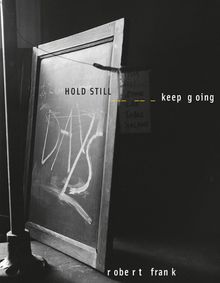 Robert Frank: Hold Still, Keep Going
Robert Frank: Hold Still, Keep Going
Published by Steidl.
Edited by Ute Eskildsen. Text by Ute Eskildsen, Christoph Ribbat, Wolfgang Beilenhoff. Interview by Ute Eskildsen.
Hold Still, Keep Going fills that void, exploring the influence of film on Frank’s photographic work, and the interaction between the still and moving image that has engaged the photographer and experimental filmmaker since the late 1950s. The book adopts a nonchronological approach, including photographs, film stills, 35mm filmstrips, as well as photomontages that present Frank’s most famous series alongside less known work; from these varied contents, the volume offers revealing juxtapositions, rendering the seemingly disjointed arc of Frank’s art more cohesive. Text, from handwritten phrases on photographs (of which “HOLD STILL—keep going” is but one example) to the dialogue in his films, emerges as a crucial tool, one that is also central to Frank’s photo-diaries.
Including a new essay from Tobia Bezzola, director of the Museum Folkwang, this edition highlights some of the more obscure work by perhaps the world’s best-known living photographer, and is an essential addition to all photography and film collections.
PUBLISHER
Steidl
BOOK FORMAT
Hardcover, 8.25 x 10.75 in. / 168 pgs / illustrated throughout.
PUBLISHING STATUS
Pub Date 11/22/2016
Active
DISTRIBUTION
D.A.P. Exclusive
Catalog: FALL 2016 p. 30
PRODUCT DETAILS
ISBN 9783869309040 TRADE
List Price: $40.00 CAD $54.00
AVAILABILITY
In stock
in stock $40.00 Free Shipping UPS GROUND IN THE CONTINENTAL U.S. |
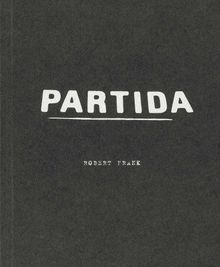 Robert Frank: Partida
Robert Frank: Partida
Published by Steidl.
PUBLISHER
Steidl
BOOK FORMAT
Hardcover, 9 x 10 in. / 56 pgs / illustrated throughout.
PUBLISHING STATUS
Pub Date 9/30/2014
Active
DISTRIBUTION
D.A.P. Exclusive
Catalog: FALL 2014 p. 12
PRODUCT DETAILS
ISBN 9783869307954 TRADE
List Price: $30.00 CAD $40.00
AVAILABILITY
In stock
in stock $30.00 Free Shipping UPS GROUND IN THE CONTINENTAL U.S. |
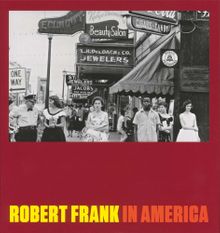 Robert Frank: In America
Robert Frank: In America
Published by Steidl.
Edited with text by Peter Galassi.
PUBLISHER
Steidl
BOOK FORMAT
Clth, 9.5 x 10 in. / 196 pgs / illustrated throughout.
PUBLISHING STATUS
Pub Date 11/30/2014
Active
DISTRIBUTION
D.A.P. Exclusive
Catalog: FALL 2014
PRODUCT DETAILS
ISBN 9783869307350 TRADE
List Price: $55.00 CAD $72.50
AVAILABILITY
Out of stock
STATUS: Out of stock Temporarily out of stock pending additional inventory. |
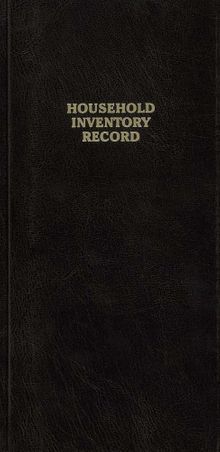 Robert Frank: Household Inventory Record
Robert Frank: Household Inventory Record
Published by Steidl.
PUBLISHER
Steidl
BOOK FORMAT
Hardcover, 5.75 x 11.25 in. / 83 pgs / illustrated throughout.
PUBLISHING STATUS
Pub Date 12/15/2013
Active
DISTRIBUTION
D.A.P. Exclusive
Catalog: FALL 2014
PRODUCT DETAILS
ISBN 9783869306605 TRADE
List Price: $35.00 CAD $47.50
AVAILABILITY
In stock
in stock $35.00 Free Shipping UPS GROUND IN THE CONTINENTAL U.S. |
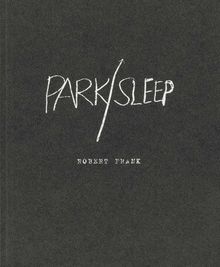 Robert Frank: Park / Sleep
Robert Frank: Park / Sleep
Published by Steidl.
PUBLISHER
Steidl
BOOK FORMAT
Paperback, 8 x 10 in. / 72 pgs / illustrated throughout.
PUBLISHING STATUS
Pub Date 1/30/2013
Active
DISTRIBUTION
D.A.P. Exclusive
Catalog: FALL 2014
PRODUCT DETAILS
ISBN 9783869305851 TRADE
List Price: $30.00 CAD $40.00
AVAILABILITY
In stock
in stock $30.00 Free Shipping UPS GROUND IN THE CONTINENTAL U.S. |
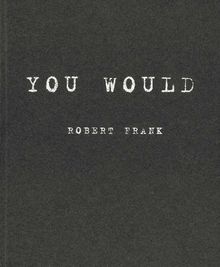 Robert Frank: You Would
Robert Frank: You Would
Published by Steidl.
PUBLISHER
Steidl
BOOK FORMAT
Paperback, 8 x 10 in. / 48 pgs / illustrated throughout.
PUBLISHING STATUS
Pub Date 1/15/2012
Active
DISTRIBUTION
D.A.P. Exclusive
Catalog: FALL 2014
PRODUCT DETAILS
ISBN 9783869304182 TRADE
List Price: $30.00 CAD $40.00
AVAILABILITY
In stock
in stock $30.00 Free Shipping UPS GROUND IN THE CONTINENTAL U.S. |
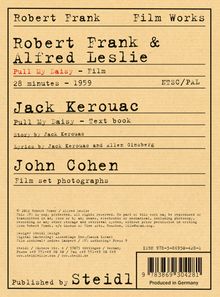 Robert Frank: Pull My Daisy
Robert Frank: Pull My Daisy
Published by Steidl.
Contributions by Jack Kerouac, Allen Ginsberg, John Cohen.
PUBLISHER
Steidl
BOOK FORMAT
DVD video, 5.75 x 7.75 in.
PUBLISHING STATUS
Pub Date 6/19/2012
Out of print
DISTRIBUTION
D.A.P. Exclusive
Catalog: FALL 2014
PRODUCT DETAILS
ISBN 9783869304281 TRADE
List Price: $35.00 CAD $47.50
AVAILABILITY
Not available
STATUS: Out of print | 00/00/00 For assistance locating a copy, please see our list of recommended out of print specialists |
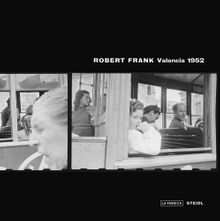 Robert Frank: Valencia
Robert Frank: Valencia
Published by Steidl.
Edited by Vicente Todoli.
PUBLISHER
Steidl
BOOK FORMAT
Clth, 10 x 10 in. / 64 pgs / illustrated throughout.
PUBLISHING STATUS
Pub Date 10/31/2012
Active
DISTRIBUTION
D.A.P. Exclusive
Catalog: FALL 2014
PRODUCT DETAILS
ISBN 9783869305028 TRADE
List Price: $50.00 CAD $67.50
AVAILABILITY
In stock
in stock $50.00 Free Shipping UPS GROUND IN THE CONTINENTAL U.S. |
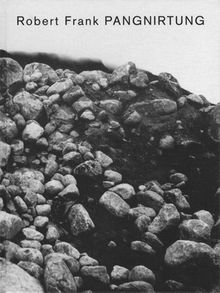 Robert Frank: Pangnirtung
Robert Frank: Pangnirtung
Published by Steidl.
PUBLISHER
Steidl
BOOK FORMAT
Clth, 9 x 12 in. / 42 pgs / illustrated throughout.
PUBLISHING STATUS
Pub Date 2/1/2011
Active
DISTRIBUTION
D.A.P. Exclusive
Catalog: FALL 2014
PRODUCT DETAILS
ISBN 9783869301983 TRADE
List Price: $40.00 CAD $54.00
AVAILABILITY
In stock
in stock $40.00 Free Shipping UPS GROUND IN THE CONTINENTAL U.S. |
 Robert Frank: Tal uf Tal ab
Robert Frank: Tal uf Tal ab
Published by Steidl.
PUBLISHER
Steidl
BOOK FORMAT
Paperback, 8 x 10 in. / 40 pgs / illustrated throughout.
PUBLISHING STATUS
Pub Date 8/1/2010
Active
DISTRIBUTION
D.A.P. Exclusive
Catalog: FALL 2014
PRODUCT DETAILS
ISBN 9783869301013 TRADE
List Price: $30.00 CAD $40.00
AVAILABILITY
Out of stock
STATUS: Out of stock Temporarily out of stock pending additional inventory. |
 Robert Frank: Away
Robert Frank: Away
Published by Steidl/The Robert Frank project.
PUBLISHER
Steidl/The Robert Frank project
BOOK FORMAT
Slip pbk, 3 volumes, 5 x 8 in. / 76 pgs / 121 color.
PUBLISHING STATUS
Pub Date 4/1/2009
Forthcoming
DISTRIBUTION
D.A.P. Exclusive
Catalog: FALL 2014
PRODUCT DETAILS
ISBN 9783865218117 TRADE
List Price: $35.00 CAD $40.00
AVAILABILITY
Awaiting stock
STATUS: Forthcoming | 4/1/2009 This title is not yet published in the U.S. To pre-order or receive notice when the book is available, please email orders @ artbook.com |
 Looking In: Robert Frank's The Americans
Looking In: Robert Frank's The Americans
Expanded Edition
Published by National Gallery Of Art, Washington/Steidl.
Edited with text by Sarah Greenough. Text by Anne Wilkes Tucker, Stuart Alexander, Martin Gasser, Jeff Rosenheim, Michel Frizot, Luc Sante, Philip Brookman.
Looking In: Robert Frank's "The Americans" celebrates the fiftieth anniversary of this prescient book. Drawing on newly examined archival sources, it provides a fascinating in-depth examination of the making of the photographs and the book's construction, using vintage contact sheets, work prints and letters that literally chart Frank's journey around the country on a Guggenheim grant in 1955–56. Curator and editor Sarah Greenough and her colleagues also explore the roots of The Americans in Frank's earlier books, which are abundantly illustrated here, and in books by photographers Walker Evans, Bill Brandt and others. The 83 original photographs from The Americans are presented in sequence in as near vintage prints as possible. The catalogue concludes with an examination of Frank's later reinterpretations and deconstructions of The Americans, bringing full circle the history of this resounding entry in the annals of photography. This volume is a reprint of the 2009 edition.
PUBLISHER
National Gallery Of Art, Washington/Steidl
BOOK FORMAT
Hardcover, 9.25 x 11.5 in. / 528 pgs / 108 color / 210 duotone / 168 tritone.
PUBLISHING STATUS
Pub Date 1/1/2009
Active
DISTRIBUTION
D.A.P. Exclusive
Catalog: MID WINTER 2008 p. 98
PRODUCT DETAILS
ISBN 9783865218063 TRADE
List Price: $90.00 CAD $120.00
AVAILABILITY
Out of stock
STATUS: Out of stock Temporarily out of stock pending additional inventory. |
 Robert Frank: Hold Still, Keep Going
Robert Frank: Hold Still, Keep Going
Published by Steidl/The Robert Frank Project.
Edited by Ute Eskildsen. Text by Ute Eskildsen, Christoph Ribbat, Wolfgang Beilenhoff. Interview by Ute Eskildsen.
PUBLISHER
Steidl/The Robert Frank Project
BOOK FORMAT
Hardcover, 8 x 10.5 in. / 168 pgs / illustrated throughout.
PUBLISHING STATUS
Pub Date 4/1/2009
Out of print
DISTRIBUTION
D.A.P. Exclusive
Catalog: SPRING 2010 p. 90
PRODUCT DETAILS
ISBN 9783865218124 TRADE
List Price: $59.95 CAD $70.00
AVAILABILITY
Not available
STATUS: Out of print | 00/00/00 For assistance locating a copy, please see our list of recommended out of print specialists |
 Robert Frank: The Complete Film Works: Volume 1
Robert Frank: The Complete Film Works: Volume 1
Pull My Daisy, The Sin of Jesus, Me and My Brother
Published by Steidl/The Robert Frank Project.
PUBLISHER
Steidl/The Robert Frank Project
BOOK FORMAT
Boxed set of 3 DVDs (PAL & NTSC), 5 x 8.25 in.
PUBLISHING STATUS
Pub Date 5/1/2008
Out of print
DISTRIBUTION
D.A.P. Exclusive
Catalog: SPRING 2008 p. 90
PRODUCT DETAILS
ISBN 9783865213655 TRADE
List Price: $125.00 CAD $150.00
AVAILABILITY
Not available
STATUS: Out of print | 00/00/00 For assistance locating a copy, please see our list of recommended out of print specialists |
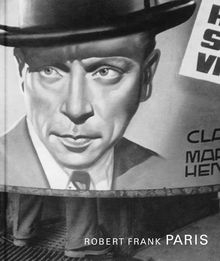 Robert Frank: Paris
Robert Frank: Paris
Published by Steidl.
Edited by Robert Frank, Ute Eskildsen.
PUBLISHER
Steidl
BOOK FORMAT
Clothbound, 7.5 x 8.75 in. / 108 pgs / 80 tritone.
PUBLISHING STATUS
Pub Date 5/1/2008
Active
DISTRIBUTION
D.A.P. Exclusive
Catalog: FALL 2007 p. 63
PRODUCT DETAILS
ISBN 9783865215246 TRADE
List Price: $45.00 CAD $60.00
AVAILABILITY
In stock
in stock $45.00 Free Shipping UPS GROUND IN THE CONTINENTAL U.S. |
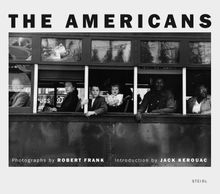 Robert Frank: The Americans
Robert Frank: The Americans
Published by Steidl.
Introduction by Jack Kerouac.
PUBLISHER
Steidl
BOOK FORMAT
Clth, 8.25 x 7.25 in. / 180 pgs / 83 tritone.
PUBLISHING STATUS
Pub Date 5/15/2008
Out of print
DISTRIBUTION
D.A.P. Exclusive
Catalog: SPRING 2008 p. 180
PRODUCT DETAILS
ISBN 9783865215840 TRADE
List Price: $40.00 CAD $54.00
AVAILABILITY
Not available
STATUS: Out of print | 00/00/00 For assistance locating a copy, please see our list of recommended out of print specialists |
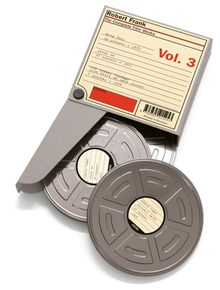 Robert Frank: The Complete Film Works: Vol. 3
Robert Frank: The Complete Film Works: Vol. 3
Keep Busy, About Me: A Musical, S-8 Stones Footage from Exile on Main Street
Published by Steidl/The Robert Frank Project.
PUBLISHER
Steidl/The Robert Frank Project
BOOK FORMAT
Boxed set of 3 DVDs (PAL & NTSC), 5 x 8.25 in.
PUBLISHING STATUS
Pub Date 7/1/2008
Active
DISTRIBUTION
D.A.P. Exclusive
Catalog: SPRING 2008 p. 90
PRODUCT DETAILS
ISBN 9783865215918 TRADE
List Price: $125.00 CAD $150.00
AVAILABILITY
Out of stock
STATUS: Out of stock Temporarily out of stock pending additional inventory. |
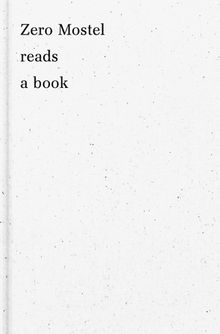 Robert Frank: Zero Mostel Reads a Book
Robert Frank: Zero Mostel Reads a Book
Published by Steidl.
PUBLISHER
Steidl
BOOK FORMAT
Hardback, 5.5 x 7.75 in. / 40 pgs / 36 tritone.
PUBLISHING STATUS
Pub Date 4/1/2008
Active
DISTRIBUTION
D.A.P. Exclusive
Catalog: SPRING 2008 p. 90
PRODUCT DETAILS
ISBN 9783865215864 TRADE
List Price: $20.00 CAD $27.95
AVAILABILITY
In stock
in stock $20.00 Free Shipping UPS GROUND IN THE CONTINENTAL U.S. |
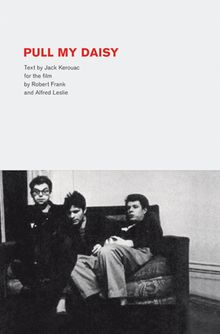 Robert Frank: Pull My Daisy
Robert Frank: Pull My Daisy
Published by Steidl.
Introduction by Jerry Tallmer. Text by Jack Kerouac.
PUBLISHER
Steidl
BOOK FORMAT
Hardback, 5.5 x 8 in. / 64 pgs / 53 tritone.
PUBLISHING STATUS
Pub Date 5/1/2008
Active
DISTRIBUTION
D.A.P. Exclusive
Catalog: FALL 2008 p. 71
PRODUCT DETAILS
ISBN 9783865216731 TRADE
List Price: $20.00 CAD $27.95
AVAILABILITY
Out of stock
STATUS: Out of stock Temporarily out of stock pending additional inventory. |
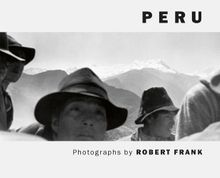 Robert Frank: Peru
Robert Frank: Peru
Published by Steidl.
PUBLISHER
Steidl
BOOK FORMAT
Hardback, 10 x 8 in. / 48 pgs / 39 tritone.
PUBLISHING STATUS
Pub Date 10/1/2008
Active
DISTRIBUTION
D.A.P. Exclusive
Catalog: FALL 2008 p. 71
PRODUCT DETAILS
ISBN 9783865216922 TRADE
List Price: $35.00 CAD $47.50
AVAILABILITY
Out of stock
STATUS: Out of stock Temporarily out of stock pending additional inventory. |
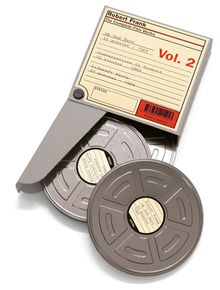 Robert Frank: The Complete Film Works: Volume 2
Robert Frank: The Complete Film Works: Volume 2
Conversations in Vermont, Liferaft Earth, OK End Here
Published by Steidl/The Robert Frank Project.
Robert Frank was born in Zurich, Switzerland, in 1924 and went to the United States in 1947. He is best known for his seminal book The Americans, first published in 1958, which gave rise to a distinct new art form in the photo book, and his experimental film Pull My Daisy, made in 1959.
PUBLISHER
Steidl/The Robert Frank Project
BOOK FORMAT
Boxed set of 3 DVDs (PAL & NTSC), 5 x 8.25 in.
PUBLISHING STATUS
Pub Date 12/1/2007
Out of print
DISTRIBUTION
D.A.P. Exclusive
Catalog: SPRING 2008 p. 90
PRODUCT DETAILS
ISBN 9783865215253 TRADE
List Price: $125.00 CAD $150.00
AVAILABILITY
Not available
STATUS: Out of print | 00/00/00 For assistance locating a copy, please see our list of recommended out of print specialists |
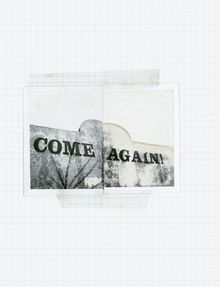 Robert Frank: Come Again
Robert Frank: Come Again
Published by Steidl.
Photographs by Robert Frank.
PUBLISHER
Steidl
BOOK FORMAT
Paperback, 8.5 x 11 in. / 48 pgs.
PUBLISHING STATUS
Pub Date 11/15/2006
Out of print
DISTRIBUTION
D.A.P. Exclusive
Catalog: FALL 2006 p. 80
PRODUCT DETAILS
ISBN 9783865212610 TRADE
List Price: $40.00 CAD $54.00
AVAILABILITY
Not available
STATUS: Out of print | 00/00/00 For assistance locating a copy, please see our list of recommended out of print specialists |
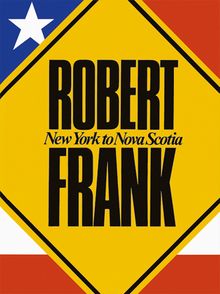 Robert Frank: New York To Nova Scotia
Robert Frank: New York To Nova Scotia
Published by Steidl.
Essays by Philip Brookman, Robert Coles and Anne Wilkes Tucker. Introduction by Peter C. Marzio.
PUBLISHER
Steidl
BOOK FORMAT
Paperback, 9 x 12 in. / 112 pgs / 4 color / 27 duotone.
PUBLISHING STATUS
Pub Date 6/15/2005
Active
DISTRIBUTION
D.A.P. Exclusive
Catalog: SPRING 2005 p. 9
PRODUCT DETAILS
ISBN 9783865210135 TRADE
List Price: $45.00 CAD $60.00
AVAILABILITY
In stock
in stock $45.00 Free Shipping UPS GROUND IN THE CONTINENTAL U.S. |

